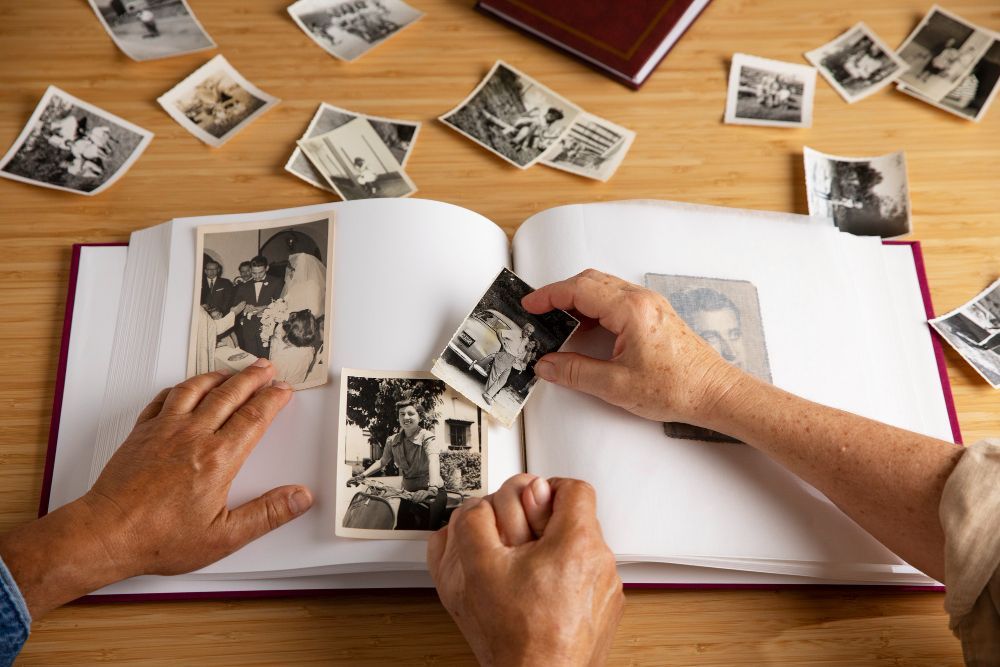Storytelling has long been a cornerstone of human experience, providing a means to connect, understand, and heal.
In the context of funeral services, storytelling can serve as a powerful therapeutic tool, helping mourners navigate their grief and celebrate the life of the deceased. The act of sharing stories can transform a funeral from a somber occasion into a meaningful tribute that fosters connection and healing.
What are the benefits of storytelling at a funeral?
There are a vast range of benefits to telling a story at a funeral. Ultimately, storytelling is a powerful tool that families or loved ones can use to celebrate the life of the deceased. Storytelling introduces new perspectives to someones character, helps to build on memories, helps to foster healing and more. We put together a list of the top benefits to storytelling at a funeral:

Emotional Expression
Grieving individuals often struggle to articulate their feelings. Storytelling offers a structured yet personal way to express complex emotions, allowing you to share memories, thoughts, and emotions about the deceased. This expression can be cathartic, providing a release of pent-up grief and a way to process loss.
Memory Preservation
Sharing stories helps preserve the legacy of the deceased. It keeps their memory alive and allows future generations to understand and appreciate their life and values. This preservation can offer a sense of continuity and comfort to those left behind. This also means that a sense of closure is being built around the foundations of a memory, and ultimately storytelling can help resolve feelings of isolation,
Community Building
Funeral services often bring together a diverse group of people who may not know each other well. The recently deceased might have known a range of different people, all of which don't know each other, but they all have one thing in common, the deceased. Storytelling can create a sense of community among mourners, as they discover shared experiences and emotions. This collective remembrance helps to foster support networks that are crucial during the grieving process.
Storytelling creates meaning
Grief can often leave individuals questioning the meaning and purpose of life and death. Storytelling helps in making sense of the loss by reflecting on the life lived and the impact made by the deceased. It allows mourners to find solace in the meaningful narratives of their loved one’s life. Rather, than to be stuck on the fact that they are now gone, granted they will still feel this way, but the beauty of storytelling is that it reminds everyone of the full life that the individual lead.
Healing and acceptance
Hearing and sharing stories about the deceased can facilitate acceptance of the loss. It helps mourners move through different stages of grief by acknowledging the reality of death while celebrating the life that was lived. This dual focus can promote healing and provide a balanced perspective on loss and love.
Incorporating storytelling into funeral services
To effectively integrate storytelling into funeral services, it is essential to create an environment that encourages sharing and honors the deceased’s life and legacy. Here are some practical steps to incorporate storytelling:
- Eulogies and Reminiscences: Invite family members and close friends to deliver eulogies or share personal memories. Encourage them to highlight the character, achievements, and quirks of the deceased, making the stories as personal and detailed as possible.
- Memory Tables and Boards: Set up tables or boards where guests can place photos, letters, and mementos. Include a space where attendees can write down their memories or stories, creating a collective tribute that can be cherished by the family.
- Interactive Storytelling: During the service, create moments for interactive storytelling. This can be done through an 'open mic' session where attendees are invited to share brief stories or memories. Alternatively, smaller group discussions can be had to encourage more intimate sharing.
- Digital Tributes: Utilise technology to gather and share stories. Create a digital memorial page or a slideshow that features photos, videos, and written memories from various people. This can be displayed during the service and accessed by those who couldn’t attend in person.
- Storytelling Rituals: Incorporate rituals that involve storytelling, such as a memory candle ceremony where each participant lights a candle and shares a story or a symbolic act like planting a tree or releasing balloons, with each participant narrating a memory associated with the deceased.
Final thoughts
Storytelling in funeral services is more than just a means of honoring the deceased; it is a profound therapeutic practice that aids in the grieving process. By sharing stories, mourners can express their emotions, preserve memories, build community, make meaning, and ultimately, find healing. When thoughtfully incorporated into funeral services, storytelling transforms mourning into a celebration of life, providing solace and connection to those who grieve.
How else can we help?
Can’t find what you’re looking for?
We’re happy to answer any questions you have. Just drop us a line, or give us a call.
01902 246 040 // 81 Tempest Street, Wolverhampton, WV2 1AA
Tailored Funerals. All Rights Reserved | Privacy Policy | Terms of Business




